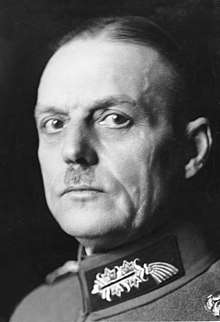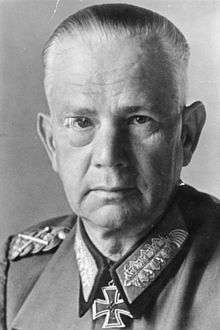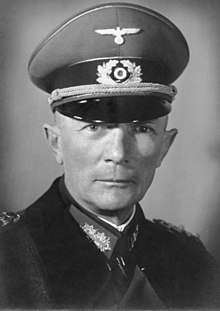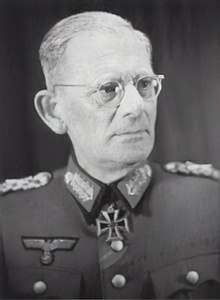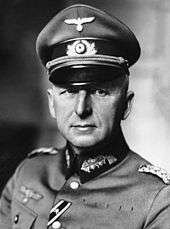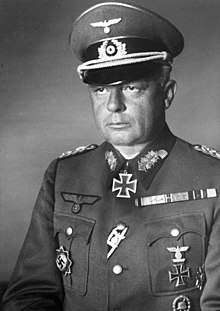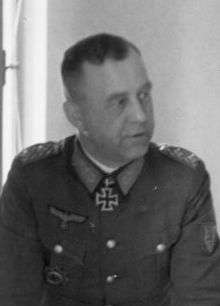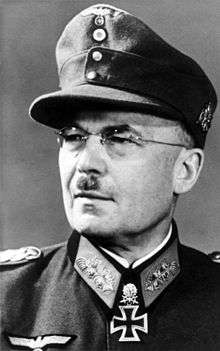Army Group South
Army Group South (German: Heeresgruppe Süd) was the name of three German Army Groups during World War II.
| Army Group South Heeresgruppe Süd | |
|---|---|
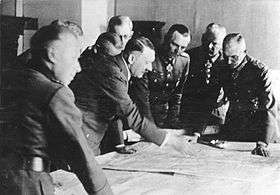 Briefing at the headquarters of Army Group South at Poltava on 1 June 1942 | |
| Active | 1 September - 26 October 1939 22 June 1941 - 3 April 1944 23 September 1944 - 1 April 1945 |
| Country | |
| Branch | German Army Group |
| Engagements | World War II
|
| Commanders | |
| Notable commanders | Gerd von Rundstedt Fedor von Bock |
It was first used in the 1939 September Campaign, along with Army Group North to invade Poland. In the invasion of Poland Army Group South was led by Gerd von Rundstedt and his chief of staff Erich von Manstein.
Two years later, Army Group South became one of three army groups into which Germany organised their forces for Operation Barbarossa. Army Group South's principal objective was to capture Soviet Ukraine and its capital Kiev.[1]
In September 1944, the Army Group South Ukraine was renamed Army Group South in Eastern Hungary. She fought in Western Hungary until March 1945 and retired to Austria at the end of the Second World War, where it was renamed Army Group Ostmark on 2 April 1945.
Operation Barbarossa
Ukraine was a major center of Soviet industry and mining and had the good farmland required for Hitler's plans for the Lebensraum ('living space'). Army Group South was to advance up to the Volga River, engaging a part of the Red Army and thus clearing the way for the Army Group North and the Army Group Center on their approach to Leningrad and Moscow respectively.
To carry out these initial tasks its battle order included the First Panzer Group (Gen. Kleist) and the German Sixth (Gen. Reichenau), Seventeenth (Gen. Stulpagel) and Eleventh Armies (Gen. Shobert), Luftlotte 1 (Keller) and the Romanian Third and Fourth Armies.
In preparation for Operation Blue, the 1942 campaign in southern Russia and the Caucasus, Army Group South was split into two army groups: Army Group A and Army Group B.[2]
In February 1943, Army Group Don and the existing Army Group B were combined and re-designated Army Group South. A new Army Group B became a major formation elsewhere. The German Sixth Army, which was destroyed in the destructive Battle of Stalingrad, was re-constituted and later made part of Army Group South in March 1943. On 4 April 1944, Army Group South was re-designated Army Group North Ukraine. Army Group North Ukraine existed from 4 April to 28 September.
In September 1944, Army Group South Ukraine was again re-designated Army Group South. At the end of World War II in Europe, Army Group South was again renamed; as Army Group Ostmark, the remnants of Army Group South ended the war fighting in and around Austria and Protectorate of Bohemia and Moravia. Army Group Ostmark was one of the last major German military formations to surrender to the Allies.
Order of Battle for Army Group South, October 1944
| Army Group | Army | Corps | Division | Remarks | |||||||||
|---|---|---|---|---|---|---|---|---|---|---|---|---|---|
| South Gen Friessner |
German Sixth Army Gen Fretter-Pico |
IV Panzer Corps LtGen Kleeman |
24th Panzer Division |
||||||||||
| LXXII Army Corps LtGen Schmidt |
76th Infantry Division |
||||||||||||
| Hungarian VII Army Corps MajGen Vörös |
Hungarian 8th Reserve Division |
||||||||||||
| Hungarian 12th Reserve Division |
|||||||||||||
| III Panzer Corps LtGen Breith |
1st Panzer Division |
||||||||||||
| 13th Panzer Division |
|||||||||||||
| 23rd Panzer Division |
|||||||||||||
| Feldherrnhalle Panzergrenadier Division |
|||||||||||||
| 22nd SS Cavalry Division Maria Theresa |
|||||||||||||
| 46th Infantry Division |
|||||||||||||
| 503rd Heavy Tank Battalion |
|||||||||||||
| German Eighth Army Gen Wöhler |
German XVII Army Corps LtGen Kreysing |
German 8th 8th Jäger Division |
|||||||||||
| Hungarian 27th Infantry Division |
|||||||||||||
| Hungarian 9th Frontier Brigade |
|||||||||||||
| Hungarian IX Army Corps BrigGen Kovács |
German 3rd Mountain Division |
||||||||||||
| Hungarian 2nd Replacement Division |
|||||||||||||
| German XXIX Army Corps LtGen Röpke |
German 8th SS Cavalry Division Florian Geyer |
||||||||||||
| German 4th Mountain Division |
|||||||||||||
| Hungarian Second Army LtGen von Dalnoki (Attached to German Sixth Army) |
Hungarian II Army Corps MajGen Kiss |
Hungarian 2nd Armored Division |
|||||||||||
| Hungarian 25th Infantry Division |
|||||||||||||
| German 15th Infantry Division |
|||||||||||||
| Hungarian Group Finta BrigGen Finta |
Hungarian 7th Replacement Division |
||||||||||||
| Hungarian 1st Replacement Mountain Brigade |
|||||||||||||
| Hungarian 2nd Replacement Mountain Brigade |
|||||||||||||
| Army Reserve LtGen von Dalnoki |
Hungarian 9th Replacement Division |
||||||||||||
| Hungarian Third Army LtGen Heszlényi |
Hungarian VIII Army Corps MajGen Lengyel |
Hungarian 23rd Reserve Division |
|||||||||||
| Hungarian 5th Replacement Division |
|||||||||||||
| Hungarian 8th Replacement Division |
|||||||||||||
| Hungarian 1st Armored Division |
|||||||||||||
| German LVII Panzer Corps LtGen Kirchner |
4th SS Panzergrenadier Division |
||||||||||||
| Hungarian 20th Infantry Division |
|||||||||||||
| Hungarian 1st Cavalry Division |
|||||||||||||
| Army Reserve LtGen Heszlényi |
Hungarian Szent László Infantry Division |
||||||||||||
Commanders
| No. | Commander | Took office | Left office | Time in office | |
|---|---|---|---|---|---|
| 1 | Generalfeldmarschall Gerd von Rundstedt (1875–1953) | 1 September 1939 | 26 October 1939 | 55 days | |
| (1) | Generalfeldmarschall Gerd von Rundstedt (1875–1953) | 22 June 1941 | 1 December 1941 | 162 days | |
| 2 | Generalfeldmarschall Walter von Reichenau (1884–1942) | 1 December 1941 | 12 January 1942 † | 42 days | |
| 3 | Generalfeldmarschall Fedor von Bock (1880–1945) | 12 January 1942 | 9 July 1942 | 178 days | |
| 4 | Generalfeldmarschall Maximilian von Weichs (1881–1954) | 9 July 1942 | 12 February 1943 | 218 days | |
| 5 | Generalfeldmarschall Erich von Manstein (1887–1973) | 12 February 1943 | 30 March 1944 | 1 year, 47 days | |
| 6 | Generaloberst Johannes Frießner (1892–1971) | 23 September 1944 | 28 December 1944 | 96 days | |
| 7 | General der Infanterie Otto Wöhler (1894–1987) | 28 December 1944 | 6 April 1945 | 99 days | |
| 8 | Generaloberst Lothar Rendulic (1887–1971) | 7 April 1945 | 30 April 1945 | 23 days |
References
- Robert Kirchubel (2012). Operation Barbarossa 1941 (1): Army Group South. Bloomsbury Publishing. pp. 3–10. ISBN 1846036518. Illustrated.
- Adam, Wilhelm; Ruhle, Otto (2015). With Paulus at Stalingrad. Translated by Tony Le Tissier. Pen and Sword Books Ltd. p. 25. ISBN 9781473833869.
